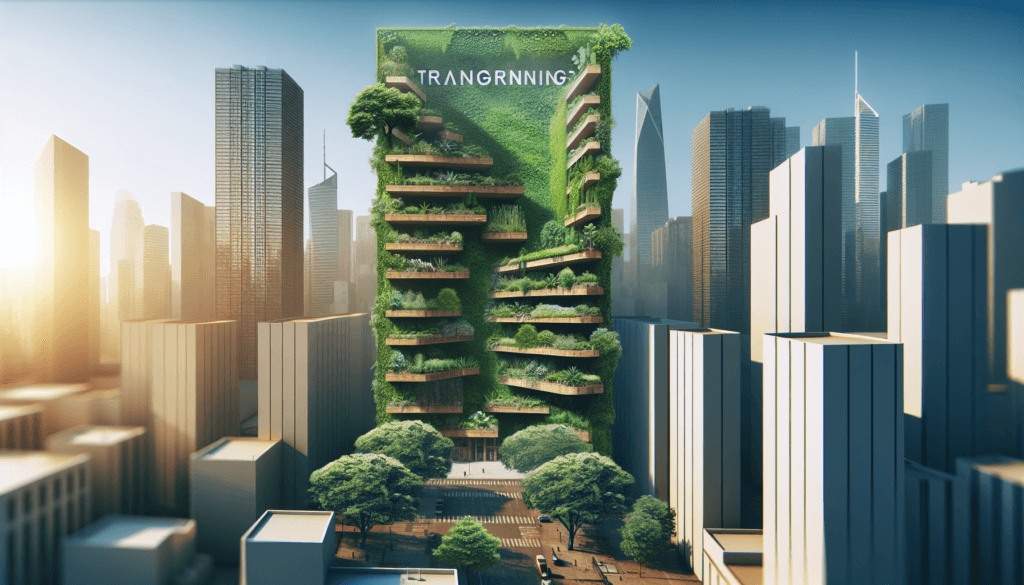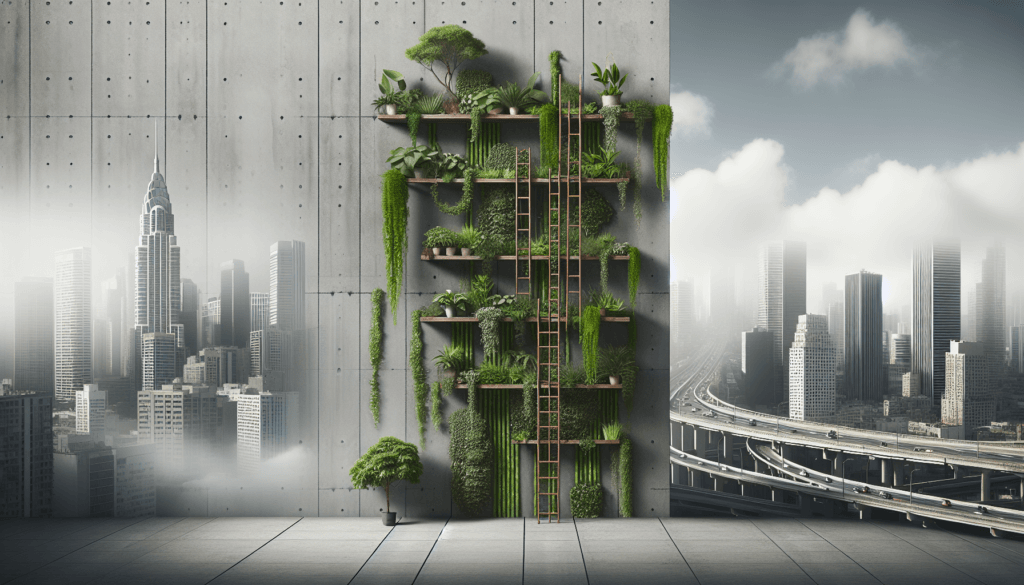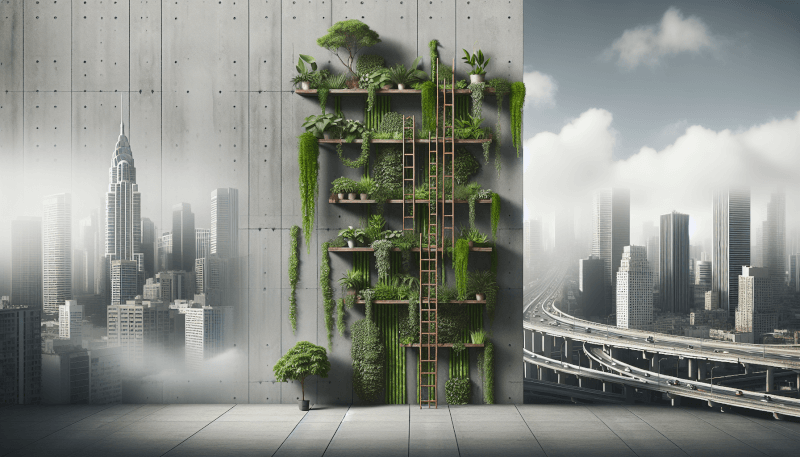Imagine looking out your apartment window and seeing a lush oasis of greenery, a vertical garden flourishing with vibrant plants and flowers. Creating a vertical garden in your urban home may seem daunting, but with the right knowledge and techniques, it can be a rewarding and space-saving way to bring nature into your living space. In this article, we will explore the best ways to create a vertical garden, from choosing the right plants to utilizing vertical structures, so that you can transform your urban home into a serene and beautiful oasis.

Choosing the Right Location
Evaluating sunlight exposure
When choosing a location for your vertical garden, it’s important to evaluate the amount of sunlight the area receives. Most plants require at least six hours of direct sunlight daily to thrive. Observe your potential garden space throughout the day to determine which areas receive the most sunlight. Consider factors such as nearby buildings or trees that may cast shadows and limit sunlight exposure. By carefully evaluating sunlight exposure, you can ensure that your plants will have the necessary light to grow and flourish.
Considering space availability
Another crucial factor to consider when choosing a location for your vertical garden is the availability of space. Take a walk around your urban home and identify areas where vertical gardening can be implemented. Look for unused walls, fences, or balcony railings that can be transformed into vibrant green spaces. Remember to choose a location with enough space to accommodate the size and number of plants you intend to grow. Adequate space allows your plants to grow and spread their roots, ensuring their overall health and longevity.
Assessing structural support
Before installing a vertical garden, it’s essential to assess the structural support of the chosen location. Different types of vertical gardens have varying weights, and not all structures may be able to handle the added load. Check if the walls, fences, or balcony railings are stable enough to support the weight of the plants, soil, and irrigation systems. If needed, consult a professional to ensure the structural integrity of the chosen location. Assessing structural support beforehand will prevent any accidents or damage to your urban home.
Determining the Suitable Vertical Garden Type
Living wall systems
Living wall systems are a popular choice for creating vertical gardens in urban homes. These systems typically consist of modular panels that can be mounted on walls or fences. They incorporate a network of pockets to hold plants and allow for vertical growth. Living wall systems provide a visually appealing display of plants and are suitable for a wide variety of plant species. They also offer easy maintenance and irrigation options, making them an excellent choice for both beginners and experienced gardeners.
Hanging planters
For those with limited space, hanging planters are a practical and space-saving option. These planters can be suspended from ceilings, hooks, or balcony railings, allowing plants to cascade downwards. Hanging planters come in various shapes and sizes, providing versatility in terms of plant selection. They are ideal for trailing plants and decorative foliage, adding a touch of green to any urban home. Hanging planters are easy to install and maintain, making them a great choice for novice gardeners.
Vertical planters or pockets
Vertical planters or pockets are an innovative solution for vertical gardening. These planters are designed with multiple pockets or compartments that can hold individual plants. They can be mounted on walls or fences, creating a visually striking vertical display. Vertical planters are available in a range of materials, from fabric to plastic, and offer flexibility in terms of plant selection. They provide an excellent opportunity to grow herbs, small vegetables, or flowering plants in a compact space.
Pallet or trellis gardens
Pallet or trellis gardens utilize vertical structures, such as pallets or trellises, to create a unique and rustic vertical garden. Pallets can be transformed into vertical planters by attaching pots or planting directly into the gaps between the wood slats. Trellises, on the other hand, offer support for climbing plants, allowing them to grow vertically. Pallet or trellis gardens are an excellent option for growing vines, vegetables, or flowers. They add a touch of charm and character to any urban home, turning even the smallest spaces into vibrant green sanctuaries.
Selecting Appropriate Plants
Assessing the area’s microclimate
Before selecting plants for your vertical garden, it’s crucial to assess the microclimate of the chosen location. Factors such as temperature, humidity, and wind patterns can significantly impact plant growth. Take note of the area’s exposure to sunlight and shade throughout the day, as it will determine which plants can thrive in the given conditions. Some plants prefer direct sunlight, while others thrive in partial shade or low-light environments. By assessing your area’s microclimate, you can select plants that are adapted to the specific conditions of your vertical garden.
Choosing plants with different light requirements
When creating a vertical garden, it’s essential to choose plants with varying light requirements to ensure optimal growth. Some plants, such as succulents and cacti, prefer direct sunlight, while others thrive in shaded areas. By selecting plants with different light requirements, you can utilize the available sunlight in your urban home to its maximum potential. This will prevent any plants from being overshadowed or deprived of the necessary light they need to thrive. Mix and match plants with varying light needs to create a diverse and visually appealing vertical garden.
Considering plant size and weight restrictions
The size and weight of plants are essential considerations when selecting plants for a vertical garden. Make sure to choose plants that can comfortably fit within the available space of your chosen vertical gardening system. Consider the mature size of the plants and allow enough room for growth without overcrowding. Additionally, ensure that the chosen structure can support the weight of the plants when fully mature. For heavier plants, such as fruit-bearing vines, make sure to provide adequate support to prevent any structural damage.
Preparing the Vertical Garden Structure
Checking for wall stability and waterproofing
Before installing a vertical garden, it’s crucial to check the stability of the chosen wall. Look for any signs of cracks or damage that may affect the structural integrity. It’s also essential to ensure that the wall is adequately waterproofed to protect it from moisture damage. If necessary, consult a professional to address any stability or waterproofing issues before proceeding with your vertical garden installation. By taking the time to inspect and prepare the wall, you can create a safe and long-lasting vertical garden in your urban home.
Constructing a frame or support
Depending on the chosen vertical gardening system, you may need to construct a frame or support structure. This is especially true for living wall systems or trellis gardens. Constructing a frame will provide stability and ensure that your plants can grow vertically without any structural limitations. Use durable materials, such as wood or metal, to build a sturdy support structure that can adequately hold the weight of the plants. Proper construction will contribute to the overall longevity and success of your vertical garden.
Adding a suitable growing medium
To ensure the optimal growth of your plants, it’s crucial to add a suitable growing medium to your vertical garden. The growing medium provides a viable environment for the plants’ root systems and contributes to their overall health. Choose a lightweight and well-draining medium that allows air circulation and retains moisture. It should also have adequate nutrients to support plant growth. Common growing media for vertical gardens include coconut coir, compost, and specialized potting mixes. Adding a suitable growing medium will provide the necessary foundation for your plants to thrive in a vertical setting.

Providing Proper Irrigation and Drainage
Choosing appropriate watering systems
Proper irrigation is essential for maintaining a healthy vertical garden. Depending on the chosen vertical gardening system, different watering systems may be suitable. For living wall systems, drip irrigation is often the preferred method as it provides consistent, targeted watering directly to the plants’ root systems. Hanging planters or vertical planters may benefit from self-watering systems that supply water at the base of the containers. Consider the specific watering needs of your chosen plants and select an appropriate irrigation system that ensures they receive the right amount of water.
Installing drip or mist irrigation systems
Drip or mist irrigation systems are commonly used in vertical gardens to provide efficient and controlled watering. Drip irrigation systems deliver water directly to the plants’ root zones, reducing water waste and preventing the foliage from getting excessively wet. Mist irrigation systems emit a fine spray that can help maintain humidity levels and provide moisture to delicate plants. Both systems can be automated or manually controlled, providing convenience and flexibility in watering your vertical garden.
Ensuring proper drainage to avoid waterlogging
Proper drainage is crucial in a vertical garden to prevent waterlogging and root rot. Ensure that your chosen vertical gardening system has adequate drainage holes to allow excess water to escape. If needed, add a layer of gravel or pebbles at the bottom of the containers to facilitate drainage. Additionally, avoid overwatering your plants to maintain the ideal moisture balance in the growing medium. Proper drainage will help to prevent water-related issues and ensure the long-term health of your vertical garden.
Implementing Vertical Garden Design
Creating a visually appealing arrangement
The design of your vertical garden plays a significant role in its overall visual impact. Consider the arrangement and placement of plants to create an aesthetically pleasing display. Arrange plants in a balanced and harmonious manner, considering their colors, textures, and sizes. Mix foliage plants with flowering ones to add pops of color. Incorporate trailing or cascading plants to add depth and dimension. By carefully arranging your plants, you can create a visually stunning vertical garden that enhances the beauty of your urban home.
Using different plant textures and colors
To create visual interest in your vertical garden, incorporate plants with different textures and colors. Mix plants with varying leaf shapes, sizes, and surface textures to add depth and contrast. Combine plants with bold, vibrant colors with those featuring subtle hues for an eye-catching display. Using a diverse range of plant textures and colors will create an attractive vertical garden that is visually appealing from any angle.
Incorporating vertical features like trellises
Take advantage of vertical features, such as trellises or support structures, to further enhance your vertical garden design. Install trellises or vertical frames that can accommodate climbing plants, adding height and vertical interest. The combination of supporting structures and climbing plants creates a dynamic and visually appealing display. Consider the size and style of your urban home and choose vertical features that complement the overall aesthetics of your vertical garden.

Maintaining the Vertical Garden
Regularly monitoring plant health
To ensure the long-term success of your vertical garden, it’s crucial to regularly monitor the health of your plants. Check for any signs of stress, pest infestations, or diseases. Inspect the leaves, stems, and overall appearance of the plants for any abnormalities. Pay attention to moisture levels in the growing medium and make any necessary adjustments to watering routines. By regularly monitoring the health of your plants, you can address any issues promptly and maintain a thriving vertical garden.
Pruning and trimming as necessary
Proper pruning and trimming are essential maintenance tasks for a vertical garden. Regularly remove dead or damaged foliage to encourage healthy growth and prevent disease spread. Trim back overgrown plants to maintain their shape and prevent overcrowding. Pruning and trimming also help manage the size of the plants and ensure they don’t overwhelm the vertical gardening structure. Take care not to over-prune and maintain a balance between plant growth and aesthetics.
Managing pests and diseases
Pests and diseases can pose a threat to the health of your vertical garden. Regularly inspect your plants for any signs of pests, such as aphids or spider mites. Quick action is crucial in managing pest infestations to prevent them from spreading to other plants. Consider natural pest control methods, such as companion planting or introducing beneficial insects, to minimize the use of chemicals. Similarly, monitor your plants for any signs of diseases, such as fungal infections, and take appropriate measures to prevent their spread. Managing pests and diseases effectively will help maintain the overall health and vitality of your vertical garden.
Maximizing Space Efficiency
Utilizing vertical space on balconies and patios
Maximizing space efficiency is vital when creating a vertical garden in an urban home. Utilize vertical space on balconies and patios by installing wall-mounted planters or hanging planters. Create a green oasis in these often underutilized areas, turning them into cozy, inviting spaces. Consider the weight restrictions and structural support of your balcony or patio and select vertical gardening systems accordingly. By utilizing vertical space, you can make the most of your urban home’s outdoor areas and enjoy the beauty of a vertical garden.
Optimizing wall and fence surfaces
Vertical gardens are an excellent way to optimize wall and fence surfaces in an urban home. Install a living wall system or vertical planters on these surfaces to transform them into vibrant green backdrops. By utilizing vertical gardening systems, you can add a touch of nature and beauty to otherwise plain and uninteresting walls or fences. Ensure proper installation and construction to prevent any damage to the existing structures and create a stunning focal point in your urban home.
Creating hanging or suspended gardens
Creating hanging or suspended gardens is another way to maximize space efficiency in your vertical garden. Hang planters from ceilings or hooks, or suspend them from beams or pergolas. This approach allows you to utilize vertical space that is often overlooked. Hanging or suspended gardens are particularly useful for growing cascading or trailing plants, adding a sense of movement and depth to your vertical garden. Consider the weight restrictions and ensure secure installation to prevent any accidents or damage.

Considering Safety Measures
Ensuring a secure installation
When creating a vertical garden, it’s essential to prioritize safety. Ensure that the chosen vertical gardening system is securely installed to prevent any accidents or structural damage. Follow the manufacturer’s instructions carefully and, if necessary, consult a professional for assistance. Ensure that all mounting brackets, hooks, or fasteners are of high quality and can handle the weight of the plants and the structure. By ensuring a secure installation, you can enjoy your vertical garden without any safety concerns.
Avoiding potential hazards for children or pets
If you have children or pets in your urban home, it’s crucial to consider potential hazards related to your vertical garden. Avoid using toxic plants or plant varieties that may pose a danger if ingested. Make sure that any irrigation systems or electrical components are safely secured and out of reach. If necessary, create a physical barrier around the vertical garden area to prevent children or pets from accessing it unsupervised. By taking necessary precautions, you can enjoy a safe and child/pet-friendly vertical garden.
Using proper anchoring and fixing techniques
Proper anchoring and fixing techniques are essential for the structural stability of your vertical garden. Use appropriate fasteners and hardware to securely install the vertical gardening system to walls, fences, or other structures. Ensure that the chosen mounting surfaces are suitable for the weight and structure of the garden. If needed, consult a professional to ensure that proper anchoring and fixing techniques are employed. By using proper techniques, you can create a structurally sound vertical garden that withstands the test of time.
Seeking Professional Assistance
Consulting a horticulturist or landscape designer
If you’re unsure about certain aspects of creating a vertical garden, consider consulting a horticulturist or landscape designer. These professionals have the expertise and knowledge to guide you in selecting the right plants, designing the garden layout, and addressing any unique challenges you may face. They can provide valuable advice on plant selection, care, and maintenance, ensuring the success of your vertical garden. Don’t hesitate to seek professional assistance to create a stunning and thriving vertical garden in your urban home.
Engaging a professional installer for complex structures
If you’re planning to create a complex vertical garden structure, such as a living wall system or trellis garden, it may be beneficial to engage a professional installer. Complex structures may require specific expertise and construction techniques to ensure their stability and longevity. Professional installers can assess your site, design a suitable structure, and execute the installation efficiently. By engaging a professional, you can have peace of mind that your vertical garden will be safely and expertly installed.
Getting advice on plant selection and care
For beginners or those unfamiliar with vertical gardening, seeking advice on plant selection and care is highly recommended. Professionals or experienced gardeners can provide guidance on selecting the right plants for your specific conditions and desired aesthetic. They can advise on plant care routines, including watering, fertilizing, and pruning. By getting expert advice, you can avoid common mistakes and ensure the success of your vertical garden.
In conclusion, creating a vertical garden in your urban home offers numerous benefits, from maximizing space efficiency to adding a touch of nature to your surroundings. By following the key considerations outlined in this article, such as choosing the right location, selecting suitable plants, and providing proper irrigation and maintenance, you can create a thriving vertical garden that enhances the beauty of your urban home. Whether you opt for a living wall system, hanging planters, or vertical planters, the possibilities are endless when it comes to designing and implementing your vertical garden. Remember to prioritize safety and, when needed, seek professional assistance to ensure a successful and rewarding vertical gardening experience. Happy gardening!



